- Home
- »
- Organic Chemicals
- »
-
Semiconductor Chemicals Market Size & Share Report, 2030GVR Report cover
![Semiconductor Chemicals Market Size, Share & Trends Report]()
Semiconductor Chemicals Market Size, Share & Trends Analysis Report By End-use (Discrete Semiconductor, Optoelectronics), By Type (High-performance Polymers, Adhesives, Solvents), By Region, And Segment Forecasts, 2024 - 2030
- Report ID: GVR-4-68040-268-3
- Number of Report Pages: 120
- Format: PDF, Horizon Databook
- Historical Range: 2018 - 2023
- Forecast Period: 2024 - 2030
- Industry: Bulk Chemicals
Semiconductor Chemicals Market Trends
The global semiconductor chemicals market size was estimated at USD 13.2 billion in 2023 and is projected to grow at a CAGR of 11.9% from 2024 to 2030. This growth can be attributed to the increasing demand for consumer electronics, such as tablets and smartphones, along with other major sectors, such as automotive, due to the growing use of electric vehicles (EVs) around the globe. Semiconductor chemicals refer to solid chemical compounds or elements that conduct electricity under specific conditions. They are known for their power efficiency, compactness, and reliability, making them essential for manufacturing electronic devices, such as mobile phones, integrated circuits, transistors, and more. Silicon is the most widely used semiconductor material due to its resistance to high temperatures and currents, as well as its cost-effectiveness and mechanical strength.
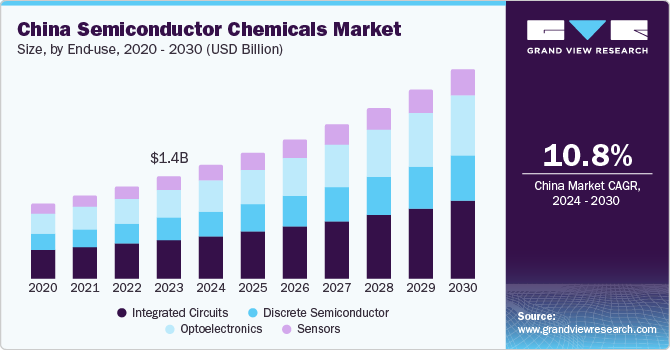
The market in Taiwan is witnessing intense competition and significant investments in research and development. The country is home to Taiwan Semiconductor Integrated Circuits Co. (TSMC), which singlehandedly manufactures roughly 50% of the world's semiconductors or microprocessor chips. TSMC's market influence extends to major technology firms, such as Apple, Qualcomm, and Nvidia, making Taiwan a critical player in the microprocessor chips industry. In addition, the Taiwanese government’s prioritization of the semiconductor industry as a driver of economic growth and technological leadership is attracting investments and initiatives to boost the domestic market for semiconductor materials.
Advanced end-use technologies, such as smaller transistor sizes and improved lithography techniques, are enabling more powerful and energy-efficient materials. The growing prominence of 5G technology is driving the demand for microprocessor chips capable of handling higher data speeds. In addition, the emergence of artificial intelligence (AI) and the Internet of Things (IoT) are creating new opportunities for materials in various applications.
Short-term cyclical downturns, geopolitical unrest, and the lingering effects of the COVID-19 pandemic can impact industry growth. Supply chain disruptions and shortages of critical materials can also pose challenges. Moreover, the complexity and specialization of the semiconductor value chain require companies to strengthen their positions in specific areas to remain competitive.
Market Concentration & Characteristics
The semiconductor chemicals market exhibits characteristics of a consolidated market, which is evident in the distribution of market share among a small group of large firms. This consolidation is driven by several factors, including the level of innovation required, R&D costs as well as a strict regulatory environment. The microprocessor chip chemicals industry experiences limited type substitutes due to the specialized nature of the materials required for manufacturing. The unique properties and characteristics of microprocessor chips chemicals make them difficult to replace with alternative materials.
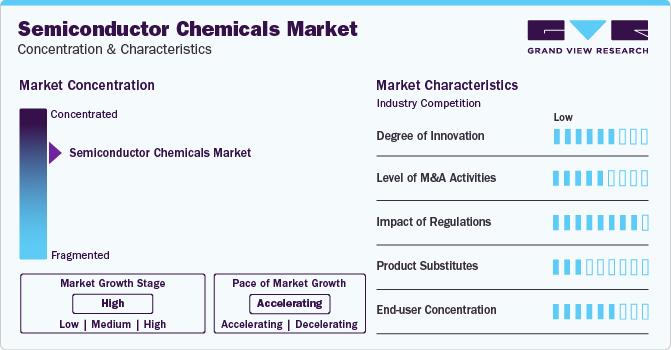
The market growth is driven by continuous innovation to meet the evolving demands of the microprocessor chips industry. Companies are investing in R&D to develop new materials, end-uses, and technologies that enhance the performance, efficiency, and reliability of microprocessor chips. Semiconductor companies are exploring innovations beyond traditional silicon-based microprocessor chips, such as the development of microprocessor chips based on compound microprocessor chip materials like silicon carbide (SiC) and gallium nitride (GaN). These innovations aim to improve power efficiency, enable smaller form factors, and cater to specific application requirements.
The market serves a concentrated group of end-user industries, including telecommunications, automotive, consumer electronics, and more. These industries heavily rely on microprocessor chips for their types and applications. For instance, the increasing adoption of high-end technology-based devices and the demand for consumer electronics drive the consumption of microprocessor chips. The concentration of end-users in these industries influences the demand and growth of the microprocessor chips chemicals market.
End-use Insights
The integrated circuits (ICs) segment dominated the market with a revenue share of 37.6% in 2023. ICs consist of multiple interconnected semiconductor or microprocessor chip devices, such as transistors, diodes, and resistors, manufactured on a single microprocessor chip wafer. They are the building blocks of electronic devices and play a crucial role in various industries. The continuous advancements in IC technology, such as the development of smaller transistor sizes and increased integration, have led to the miniaturization of electronic devices and the improvement of their performance and efficiency.
Discrete semiconductors are another important end-use segment of microprocessor chip chemicals. Discrete microprocessor chips refer to individual microprocessor chips, such as transistors, diodes, and thermistors that are not integrated into a single chip. These devices are used in various applications where specific functionalities are required. For instance, discrete transistors are used in power amplifiers, switching circuits, and voltage regulators. Diodes are utilized in rectification circuits, voltage clamping, and signal modulation.
Sensors are electronic devices that detect and measure physical or chemical stimuli from the surrounding environment. Semiconductor materials play a crucial role in the fabrication of sensors due to their electrical and optical properties. For instance, temperature sensors utilize semiconductor materials with temperature-dependent electrical characteristics to measure temperature changes. Pressure sensors use piezo-resistive semiconductor materials that change resistance in response to applied pressure.
Type Insights
The acid & base chemicals segment dominated the market with a revenue share of 38.9% in 2023. Acid & base chemicals are essential in semiconductor manufacturing end-use. They are used for various purposes, including etching, cleaning, and doping. Hydrofluoric acid (HF) is commonly used for silicon wafer etching, where it selectively removes the oxide layer from the surface. Sulfuric acid (H2SO4) is used for cleaning and removing organic contaminants from microprocessor chip surfaces. Base chemicals, such as sodium hydroxide (NaOH) and potassium hydroxide (KOH), are used for wafer cleaning and surface preparation. Acid & base chemicals play a critical role in the precise fabrication and modification of semiconductor materials, enabling intricate circuit patterns and structures.
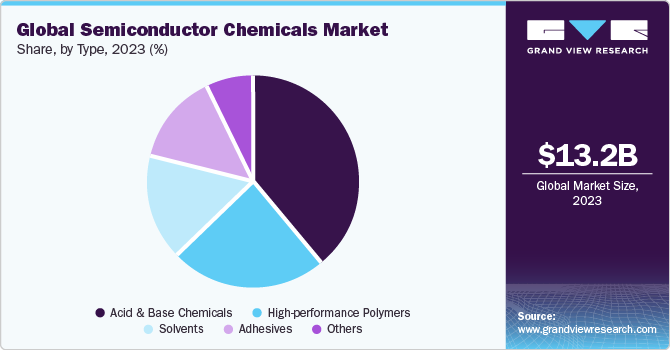
High-performance polymers are a type of semiconductor chemical that offers exceptional properties, such as thermal stability, chemical resistance, and mechanical strength. These polymers are widely used in the microprocessor chips industry for various applications. For example, polyimides, a type of high-performance polymer, are used as dielectric materials in integrated circuits due to their excellent electrical insulation properties and high-temperature stability. They enable the miniaturization of electronic components and enhance the performance and reliability of microprocessor chips.
Solvents are used in the semiconductor industry for various purposes, including cleaning, thin film deposition, and photoresist development. For example, isopropyl alcohol (IPA) is commonly used as a cleaning solvent to remove contaminants from microprocessor chips surfaces. It is effective in removing organic residues and particles without damaging the underlying materials. Solvents play a vital role in microprocessor chips manufacturing by enabling precise and controlled end-uses.
Regional Insights
The North America semiconductor chemicals market accounted for the second-largest revenue share in 2023. The regional market of North America is characterized by the presence of key microprocessor chips manufacturing hubs and a strong focus on technological innovation.
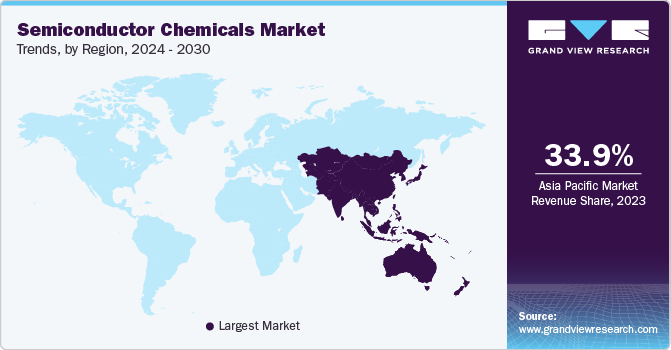
U.S. Semiconductor Chemicals Market Trends
The semiconductor chemicals market in the U.S. is estimated to grow at a significant CAGR from 2024 to 2030. The country possesses many fabrication plants and plays a crucial role in microprocessor chips manufacturing. The U.S. microprocessor chips industry is a frontrunner in the fabless segment, contributing to the global microprocessor chips market.
Asia Pacific Semiconductor Chemicals Market Trends
The Asia Pacific semiconductor chemicals market dominated the global industry with a revenue share of 33.9% in 2023. The regional market is characterized by continuous growth, technological advancements, and a strong focus on meeting the increasing demand for semiconductor materials across various end-user industries. The region's leadership in silicon-based microprocessor chips and its role in the global microprocessor chips landscape further solidify its position in the semiconductor materials sector.
The semiconductor chemicals market in China held the second-largest share in Asia Pacific in 2023. China's microprocessor chips industry is poised to become a major player in the global market, with a push by the central government to incentivize the microprocessor chips industry in the country.
Europe Semiconductor Chemicals Market Trends
The Europe semiconductor chemicals market is expected to grow at a significant rate from 2024 to 2030. The region is home to microprocessor chips R&D centers, as well as manufacturing facilities that contribute to the global microprocessor chips supply chain. The European Investment Bank (EIB) also plays a role in supporting technological and climate finance initiatives.
The semiconductor chemicals market in Germany held the largest share of the Europe market in 2023 and is home to microprocessor chips R&D centers, as well as manufacturing facilities that contribute to the global microprocessor chips supply chain.
The UK semiconductor chemicals market is expected to grow at a significant CAGR from 2024 to 2030. It is a notable contributor to the global microprocessor chip materials industry, with a focus on technological advancements, research collaborations, and regulatory considerations.
Central & South America Semiconductor Chemicals Market Trends
The semiconductor chemicals market in Central & South America is anticipated to witness significant growth from 2024 to 2030. The regional market is undergoing notable developments and growth. While this region may account for a relatively smaller portion of the global microprocessor chip materials industry, they are experiencing significant advancements in technology and infrastructure aided by private players.
The Brazil semiconductor chemicals market is estimated to grow at a significant CAGR over the forecast period. The country's microprocessor chips industry has been gaining momentum, driven by the New Semiconductor Policy, introduced in 2023, which aims to promote innovation and growth in the microprocessor chips manufacturing and ICT exports sectors.
Middle East & Africa Semiconductor Chemicals Market Trends
The semiconductor chemicals market in MEA is driven by increasing demand for consumer electronics and technological advancements. However, challenges, such as trade wars and raw material price increases, may impact the microprocessor chips industry in the region.
The Saudi Arabia semiconductor chemicals market is expected to grow at a significant rate due to improvements in recent years. The Saudi Arabian government has awarded loans and incentives to microprocessor chips manufacturers, aiming to boost the domestic market and attract investments.
Key Semiconductor Chemicals Company Insights
The competitive landscape of the global semiconductor materials market is characterized by intense competition among a few key players, technological advancements, and strategic initiatives aimed at maintaining industry leadership and driving innovation. Brand identity plays a significant role in the microprocessor chip chemicals industry, as end-users expect high-quality types from microprocessor chip manufacturers.
BASF SE, Eastman Chemical Company, FUJIFILM Corp., Honeywell International Inc., Linde PLC, and Solvay are prominent players in the industry, with established brand identities and considerable market penetration. These companies have a strong presence in the microprocessor chip chemicals industry, leveraging their brand reputation to maintain market share and drive growth.
-
BASF SE is a leading player in the semiconductor chemicals market, offering a wide range of end-use chemicals and solutions for microprocessor chips end-uses. The company has an established track record in providing chemicals for various semiconductor end-uses, including cleaning, etching, photolithography, chemical mechanical planarization (CMP), and wet deposition
-
Dow Inc. is a major player in the microprocessor chips chemicals industry, recognized for its contributions to the chemical and manufacturing sub-categories. The company's brands, including DOWSIL, EcoSense, ELECPURE, and RHOBARR, align with the evolving demands of the microprocessor chips materials market, positioning Dow Inc. as a key player in the industry
VWR International, LLC, Entegris, and SK Inc. are some of the emerging players in the semiconductor chemicals market
-
VWR International, LLC. is an emerging player from the U.S. with a focus on providing chemicals and solutions for electronics and other applications
-
Entegris is a notable emerging player in the microprocessor chips chemicals industry, particularly in the wet chemicals segment for electronics and microprocessor chips applications. The company is recognized for its significant market share and its role in providing high-quality wet chemicals for microprocessor chip end-uses
Key Semiconductor Chemicals Companies:
The following are the leading companies in the semiconductor chemicals market. These companies collectively hold the largest market share and dictate industry trends.
- Taiwan Semiconductor Integrated Circuits Company Ltd.
- BASF SE
- Eastman Chemical Company
- FUJIFILM Corporation
- Honeywell International Inc.
- Linde PLC
- Solvay
- VWR International, LLC.
- Entegris
- SK Inc.
Recent Developments
-
In August 2023, BASF expanded the electronic materials R&D center in Asia Pacific to its facility in Ansan, South Korea. The new, larger facility focuses on engineering plastics and semiconductor materials, catering to local and global customers
-
In January 2023, JSR Corp. acquired additional shares of JSR Electronic Materials Korea Co., Ltd., its Korean subsidiary. The move helped JSR solidify its global position in the semiconductor chemicals business and expand its type portfolio
Semiconductor Chemicals Market Report Scope
Report Attribute
Details
Market size value in 2024
USD 14.3 billion
Revenue forecast in 2030
USD 28.0 billion
Growth rate
CAGR of 11.9% from 2024 to 2030
Historical data
2018 - 2023
Forecast period
2024 - 2030
Quantitative units
Volume in kilotons, revenue in USD million, and CAGR from 2024 to 2030
Report coverage
Volume forecast, revenue forecast, company ranking, competitive landscape, growth factors, and trends
Segments covered
Type, end-use, region
Regional scope
North America; Europe; Asia Pacific; Central & South America; Middle East & Africa
Country scope
U.S.; Canada; Mexico; Germany; UK; France; Italy; Spain; China; Japan; India; South Korea; Taiwan; Brazil; Argentina; Saudi Arabia; South Africa
Key companies profiled
Taiwan Semiconductor Integrated Circuits Co. Ltd.; BASF SE; Eastman Chemical Company; FUJIFILM Corp.; Honeywell International Inc.; Linde PL; Solvay; VWR International, LLC; Entegris; SK Inc.
Customization scope
Free report customization (equivalent up to 8 analysts working days) with purchase. Addition or alteration to country, regional & segment scope.
Pricing and purchase options
Avail customized purchase options to meet your exact research needs. Explore purchase options
Global Semiconductor Chemicals Market Report Segmentation
This report forecasts revenue growth at global, regional, and country levels and provides an analysis of the latest trends in each of the sub-segments from 2018 to 2030. For this study, Grand View Research has segmented the global semiconductor chemicals market report based on type, end-use, and region:
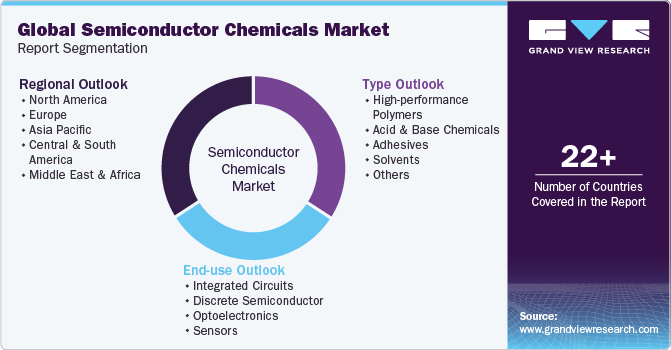
-
Type Outlook (Volume, Kilotons; Revenue, USD Million, 2018 - 2030)
-
High-performance Polymers
-
Acid & Base Chemicals
-
Adhesives
-
Solvents
-
Others
-
-
End-use Outlook (Volume, Kilotons; Revenue, USD Million, 2018 - 2030)
-
Integrated Circuits
-
Discrete Semiconductor
-
Optoelectronics
-
Sensors
-
-
Regional Outlook (Volume, Kilotons; Revenue, USD Million, 2018 - 2030)
-
North America
-
U.S.
-
Canada
-
Mexico
-
-
Europe
-
Germany
-
UK
-
France
-
Italy
-
Spain
-
-
Asia Pacific
-
China
-
Japan
-
India
-
South Korea
-
Taiwan
-
-
Central & South America
-
Brazil
-
Argentina
-
-
Middle East and Africa
-
Saudi Arabia
-
South Africa
-
-
Frequently Asked Questions About This Report
b. The global semiconductor chemicals market size was valued at USD 13.2 billion in 2023 and is anticipated to reach USD 28.0 billion by 2030
b. The global semiconductor chemicals market is anticipated to expand at a CAGR of 11.9% from 2024 to 2030 and reach USD 28.0 billion by 2030
b. Asia Pacific dominated the market with a revenue share of 33.9% share in 2023. Asia Pacific's semiconductor materials industry is characterized by continuous growth, technological advancements, and a strong focus on meeting the increasing demand for semiconductor materials across various end-user industries.
b. Some of the key players operating in the market include Taiwan Semiconductor Integrated Circuits Company Limited, BASF SE, Eastman Chemical Company, FUJIFILM Corporation, Honeywell International Inc., Linde PLC, Solvay, VWR International, LLC., Entegris, SK Inc.
b. Semiconductor Chemicals Market is driven by the increasing demand for consumer electronics such as tablets, smartphones along with other major sectors such as automotive due to the growing use of electric vehicles around the globe.
Share this report with your colleague or friend.
![gvr icn]()
NEED A CUSTOM REPORT?
We can customize every report - free of charge - including purchasing stand-alone sections or country-level reports, as well as offer affordable discounts for start-ups & universities. Contact us now
![Certified Icon]()
We are GDPR and CCPA compliant! Your transaction & personal information is safe and secure. For more details, please read our privacy policy.
We are committed towards customer satisfaction, and quality service.
"The quality of research they have done for us has been excellent."





